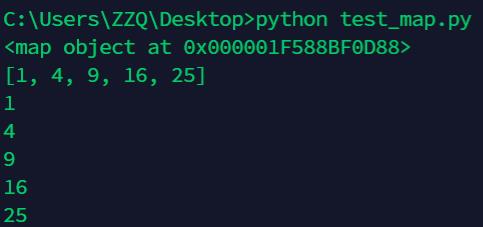python中map的用法
Posted 呆呆象呆呆
tags:
篇首语:本文由小常识网(cha138.com)小编为大家整理,主要介绍了python中map的用法相关的知识,希望对你有一定的参考价值。
0 语法描述
map()会根据提供的函数对指定序列做映射。
语法:
map(function, iterable, ...)
参数:
function函数iterable一个或多个序列
第一个参数function以参数序列中的每一个元素调用function函数,返回包含每次function函数返回值的新列表。
注意:
map()函数返回一个惰性计算lazily evaluated的迭代器iterator或map对象。就像zip函数是惰性计算那样。
不能通过index访问map对象的元素,也不能使用len()得到它的长度。
但我们可以强制转换map对象为list。
也就是说map()返回值使用一次后变为空(会在例子4中进行说明)
相对 Python2.x 提升了性能,惰性计算可以节约内存。
1 举例说明
例子1:基本用法
def square(x) : # 计算平方数
return x ** 2
print(map(square, [1,2,3,4,5])) # 计算列表各个元素的平方
print(list(map(square, [1,2,3,4,5])))
for i in map(square, [1,2,3,4,5]):
print(i)

例子2:与匿名函数合用
print(map(lambda x: x ** 2, [1, 2, 3, 4, 5])) # 计算列表各个元素的平方
print(list(map(lambda x: x ** 2, [1, 2, 3, 4, 5])))
for i in map(lambda x: x ** 2, [1, 2, 3, 4, 5]):
print(i)

例子3:输入两个列表
map_test = map(lambda x, y: x + y, [1, 3, 5, 7, 9], [2, 4, 6, 8, 10])
print(map_test) # 计算列表各个元素的平方
for i in map_test:
print(i)
print(list(map_test)) # 计算列表各个元素的平方

例子4:迭代器仅可使用一次的问题
可见第二次调用变成了空list。
因为迭代器Iterator会调用方法next()不断指向下一个元素,直到空,报StopIteration错误。
map_test = map(lambda x, y: x + y, [1, 3, 5, 7, 9], [2, 4, 6, 8, 10])
print(map_test) # 计算列表各个元素的平方
for i in map_test:
print(i)
print(list(map_test)) # 计算列表各个元素的平方

规避这个惰性计算的问题,赋值的时候直接用list进行转换一下:
print("惰性计算")
map_test = map(lambda x, y: x + y, [1, 3, 5, 7, 9], [2, 4, 6, 8, 10])
print(list(map_test))
for i in map_test:
print(i,end = " ")
print(list(map_test))
print("规避惰性计算")
map_test = list(map(lambda x, y: x + y, [1, 3, 5, 7, 9], [2, 4, 6, 8, 10]))
print(list(map_test))
for i in map_test:
print(i,end = " ")
print(list(map_test))

例子5 与lambda迭代dictionary列表
dict_list = ['name': 'python', 'points': 10, 'name': 'java', 'points': 8]
print(list(map(lambda x : x['name'], dict_list)))
print(list(map(lambda x : x['points']*10, dict_list)))
print(list(map(lambda x : x['name'] == "python", dict_list)))

LAST 参考文献
Python的map()返回值使用一次后变为空——返回的是迭代器_光逝的博客-CSDN博客
以上是关于python中map的用法的主要内容,如果未能解决你的问题,请参考以下文章